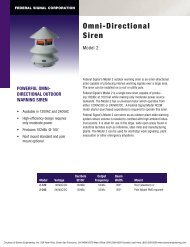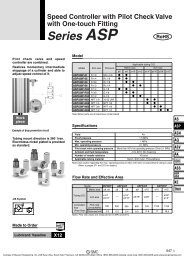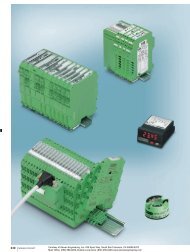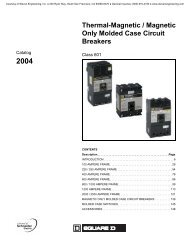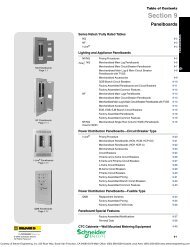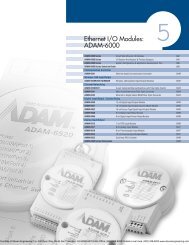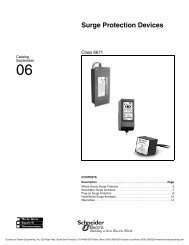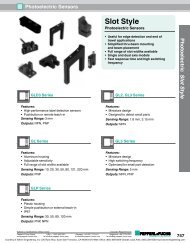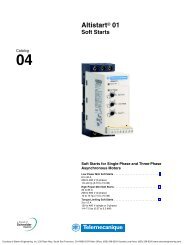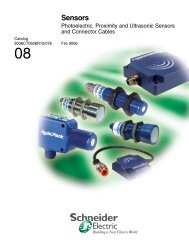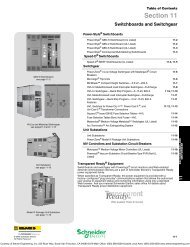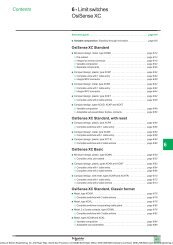resolver decoder specifications - Steven Engineering
resolver decoder specifications - Steven Engineering
resolver decoder specifications - Steven Engineering
Create successful ePaper yourself
Turn your PDF publications into a flip-book with our unique Google optimized e-Paper software.
SELECTING THE RIGHT POSITION<br />
TRANSDUCER FOR YOUR APPLICATION<br />
Even though the position transducers are the most critical<br />
parts in a motion control system, many times they are left<br />
towards the end to be designed in. A control design engineer<br />
can save himself a lot of headache by considering the transducer<br />
features and trade-offs at the beginning of the project. The<br />
following discusses various types of position transducers and<br />
the factors to consider when making a selection.<br />
Many industrial control systems need position and speed feedback.<br />
Until a few years ago, tachometers provided the speed<br />
and limit switches provided the position information.<br />
However, with new requirements of higher accuracies, faster<br />
machine speeds, and greater reliability combined with technological<br />
breakthrough in the field of electronics, a variety of<br />
new designs of position transducers emerged. These transducers<br />
made it possible to know the machine position at all times,<br />
rather than waiting for a limit switch to give position indication<br />
at a predetermined point. This permitted faster machine<br />
operation and increased throughputs.<br />
In the initial stages, the position transducers consisted of<br />
potentiometers, brush encoders, magnetic encoders and rarely<br />
optical encoders and <strong>resolver</strong>s. Each device had certain limitations.<br />
The potentiometers and magnetic encoders had limited<br />
resolution. The brush encoders required frequent maintenance.<br />
The optical encoders used incandescent lamps, which were<br />
large in size and had limited life expectancy. The <strong>resolver</strong>s<br />
could offer better resolution and accuracy, but were very<br />
expensive due to the decoding electronics required.<br />
The recent technological developments have brought some<br />
improvements in the initial models. Today optical encoders and<br />
<strong>resolver</strong>s are more commonly used in industry. The magnetic<br />
and magnetoresistive encoders find applications less frequently.<br />
We will focus on two of the more popular types of position<br />
transducers: Optical Encoders and Resolvers.<br />
Optical encoders and <strong>resolver</strong>s are available in two major categories:<br />
Absolute and Incremental. The incremental encoder,<br />
when it rotates, generates pulses, which are counted to give<br />
position information relative to a known point, whereas an<br />
absolute encoder provides a unique value at each position and<br />
retains actual shaft position even if power fails. Multi-turn<br />
units with built-in gear trains are available for linear application<br />
where it takes several revolutions of the encoder shaft to<br />
complete one machine cycle.<br />
Optical Encoders<br />
The Optical Encoders typically consist of a rotating and a stationary<br />
member. The rotor is usually a metal, glass, or a plastic<br />
disc mounted on the encoder shaft. The disc has some kind of<br />
optical pattern, which is electronically decoded to generate<br />
position information. The rotor disc in absolute optical<br />
encoder uses opaque and transparent segments arranged in a<br />
gray-code pattern. The stator has corresponding pairs of LEDs<br />
and phototransistors arranged so that the LED light shines<br />
through the transparent sections of the rotor disc and received<br />
by phototransistors on the other side. See figure below.<br />
Depending upon the shaft position, the phototransistor output<br />
is modulated in a gray-code pattern, which can be converted<br />
internally to binary or BCD. Typically CMOS, TTL-, PNP-,<br />
and NPN-type outputs with 8- or 10-bit Gray-code, binary, or<br />
BCD formats are available.<br />
The incremental optical encoders (figure 1) use a much simpler<br />
disc pattern. This slotted rotor disc alternately interrupts<br />
the light beam between the LED transmitter-receiver pair and<br />
thus produces a pulse output. The number of pulses depends<br />
on the number of slots on the disc. The pulses are then fed to<br />
a counter, where they are counted to give position information.<br />
The pulse rate indicates shaft speed. An additional LED<br />
pair can also determine the direction of rotation. Some modules<br />
also provide a marker pulse output, which is generated<br />
once every revolution at a fixed shaft position and can be used<br />
to mark a zero reference point. Many different pulse configurations<br />
are available, but the most commonly known are the<br />
quadrature encoders, where two square wave pulses 90 degrees<br />
apart from each other are generated.<br />
SECTION<br />
A<br />
Position Transducers/Sensors<br />
800-TEC-ENGR<br />
www.avg.net<br />
A-3



